
Dudleya, commonly known as liveforevers is a genus of succulent plants in the stonecrop family, Crassulaceae, consisting of about 68 taxa in southwestern North America. The species come in multiple forms, some large and evergreen, others cryptic and deciduous. The flowers of Dudleya have parts numbered in 5, and when fruiting are filled with tiny, ovoid or crescent-shaped seeds.

Dudleya abramsiisubsp. setchellii, known by the common name Dudleya setchellii, the Santa Clara Valley dudleya, or Santa Clara Valley liveforever, is a member of the Dudleya genus of succulent perennials, members of the family Crassulaceae. The Santa Clara Valley dudleya, endemic to the Santa Clara Valley region in the southern San Francisco Bay Area, was listed on February 3, 1995, as an endangered species. It is considered to be a subspecies of Dudleya abramsii, but its taxonomic status is still unclear. Its closest relative is Dudleya cymosa subsp. paniculata, which is a morphologically similar sister taxon.

Dudleya caespitosa is a succulent plant known by several common names, including sea lettuce, sand lettuce, and coast dudleya. It is endemic to California, where it grows along the coastline in the southern half of the state. Taxonomically, this species is a highly variable complex of polymorphic and polyploid plants, closely related to numerous neighboring species such as Dudleya farinosa, Dudleya greenei and Dudleya palmeri. It is delimited from neighboring species on an arbitrary basis of distribution and chromosome number, and is not immediately separable from the other species it approaches.

Dudleya candelabrum is a succulent plant known by the common name Candleholder liveforever. This Dudleya is endemic to California, where it grows wild only on the northern Channel Islands.
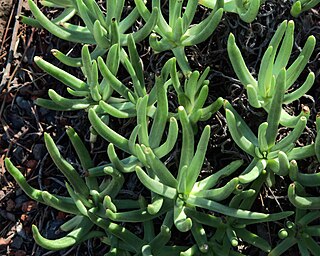
Dudleya edulis is a species of perennial succulent plant known by the common names fingertips, lady fingers, mission lettuce and the San Diego dudleya. The common name denotes the finger-like shape of the leaves, while the specific epithet edulis refers to the use of the young scapes as food by the Kumeyaay. It is native to Southern California and northern Baja California, and grows on rocky hillsides, cliffs, and bare rock.
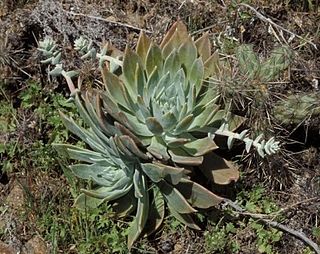
Dudleya traskiae is a rare succulent plant known by the common name Santa Barbara Island liveforever. This Dudleya is endemic to Santa Barbara Island, one of the Channel Islands of California, where it grows on rocky bluffs. The plant has a basal rosette of flat, spade-shaped fleshy leaves up to 15 centimeters long, which are pale green to yellowish. It erects tall stems bearing dense, rounded inflorescences of many bright yellow flowers.

Dudleya variegata is a succulent plant known by the common name variegated liveforever or variegated dudleya. It is native to Baja California and adjacent San Diego County in California, where it grows in several habitat types, including chaparral and vernal pools.
Sedella congdonii is a species of flowering plant in the family Crassulaceae known by the common name Congdon's mock stonecrop. It is endemic to California, where it can be found in the Sierra Nevada, often in rocky and moist habitat types. It is an annual herb growing just a few centimeters high. The oval succulent leaves are just a few millimeters long. The flowers occur in a cyme on thin branches. Each has yellow petals no more than 3 millimeters long.
Sedella leiocarpa is a rare species of flowering plant in the family Crassulaceae known by the common names Lake County mock stonecrop and Lake County stonecrop. It is endemic to Lake County, California, where it is known from only about ten occurrences in two locations. It is a resident of drying vernal pools and rocky clay flats, where it grows in colonies. It is a federally listed endangered species. This is an annual herb growing no more than four centimeters high. It is a tiny erect reddish or yellow succulent plant with sparse leaves each a few millimeters long. The flowers have yellow to reddish petals 3 or 4 millimeters long.
Sedella pentandra is a species of flowering plant in the family Crassulaceae known by the common name Mt. Hamilton mock stonecrop. It is endemic to California, where it grows in the Central Coast Ranges and adjacent sections of the Central Valley and coastline. It often grows on sandstone and serpentine soils. This is an annual herb growing no more than 8 centimeters high. It has small succulent leaves each a few millimeters long. The flowers atop the threadlike stems have fleshy sepals and yellowish petals a few millimeters in length.
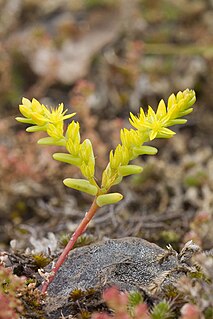
Sedella pumila is a species of flowering plant in the family Crassulaceae known by the common name Sierra mock stonecrop. It is native to California, where it grows in the North Coast Ranges and adjacent sections of the Central Valley to the Sierra Nevada foothills. It is a plant of vernal pools and similar habitat, growing in rocky and gravelly flats of serpentine soils, limestone, and soils of volcanic origin, often alongside mosses. This is an annual herb growing 2 to 17 centimeters high, in shades of green, yellow, and red. It has small knobby succulent leaves each a few millimeters long. The flowers atop the threadlike stems have fleshy sepals and yellowish petals a few millimeters in length. The flowers have a musty scent.

Sedum eastwoodiae is a rare species of flowering plant of the stonecrop Crassulaceae family. It is known by its common name Red Mountain stonecrop. It is endemic to Mendocino County, California, where it is known from only four occurrences on Red Mountain, near Ukiah. The total number of plants in existence is estimated to be around 5300. They can be found on steep, exposed, rocky mountain slopes of serpentine substrate. This species has also been treated as a subspecies of Sedum laxum.

Sedum laxum is a species of flowering plant in the family Crassulaceae known by the common name roseflower stonecrop. It is native to southwestern Oregon and northwestern California, where it can be found in rocky mountainous habitat. It is a succulent plant forming basal rosettes of oval or oblong leaves up to 3 centimeters long. The inflorescence is made up of one or more erect arrays of many flowers. The flowers have reddish or yellowish petals up to 1.3 centimeters long each.
Sedum oblanceolatum is a species of flowering plant in the family Crassulaceae known by the common names oblongleaf stonecrop and Applegate stonecrop. It is native to the Klamath Mountains of southwestern Oregon and far northern California, where it grows on many types of rocky substrate, such as serpentine soils and other ultramafics. It is a succulent plant forming basal rosettes of waxy leaves. The leaves are widely lance-shaped, widest near the distal end and narrowing to rounded or notched tips. Smaller leaves occur farther up the stem. The small inflorescence grows a few centimeters tall and bears up to 50 flowers in a flat-topped array. The flowers have cream or yellowish petals up to a centimeter long.
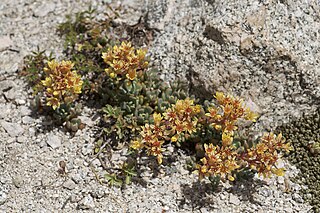
Sedum obtusatum is a species of flowering plant in the family Crassulaceae known by the common name Sierra stonecrop. It is native to the Sierra Nevada and adjacent high mountain ranges of California, its distribution extending north into Oregon and east into Nevada. It grows in rocky mountain habitat.
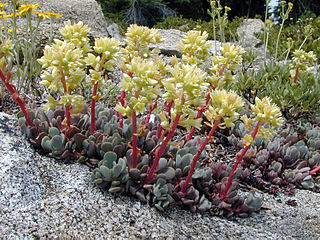
Sedum oregonense is a species of flowering plant in the family Crassulaceae known by the common name cream stonecrop. It is native to the Klamath Ranges of southern Oregon and northern California, where it grows in rocky habitat. It is a succulent plant forming basal rosettes of leaves up to about 4 centimeters long. Smaller leaves occur farther up the stem. The leaves are green in color and waxy in texture. The inflorescence is an erect, wide open array of many flowers. The flowers have yellow petals with red-tinged or white-speckled undersides.

Sedum spathulifolium is a species of flowering plant in the family Crassulaceae known by the common names broadleaf stonecrop, yellow stonecrop, and spoon-leaved stonecrop. An evergreen perennial, it is native to western North America from British Columbia to southern California, where it can be found often in shade in many types of rocky habitat in coastal and inland hills and mountains.

Hylotelephium erythrostictum, commonly known as garden stonecrop, is a herbaceous perennial plant in the genus Hylotelephium, belonging to the family Crassulaceae.

Dudleya cymosa subsp. paniculata, known by the common name Diablo Range dudleya, is a species of perennial succulent plant in the family Crassulaceae native to the Inner South Coast Range of California. It is characterized by pale yellowish flowers, oblong to oblanceolate leaves and a growth habit not limited to a single substrate. It is closely related to Dudleya abramsii subsp. setchellii.

Dudleya saxosasubsp. aloides is a species of perennial succulent plant in the family Crassulaceae known by the common names desert dudleya or desert savior. It is a rosette-forming species widely distributed throughout the Peninsular Ranges and desert mountains of California in the United States. It is characterized by bright-yellow or greenish-yellow flowers, and can be found in shaded crevices and slopes. Plants in western half of the range may grade into Dudleya lanceolata.
















